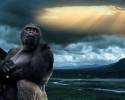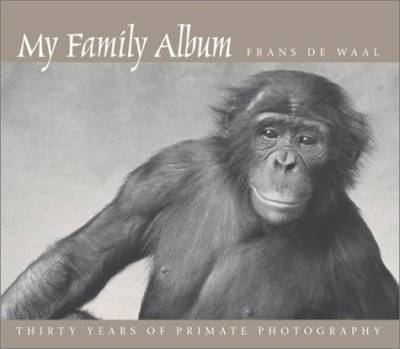Book Review - God- or Gorilla?, Chapter 23
This entry is part of a series. For a bit of an introduction and an index of all entries in the series, go here.
 This installment covers Chapter 23, Evolution Upside Down.
This installment covers Chapter 23, Evolution Upside Down.
Now here's an understatement.
Yet, when we come to man, the contradictions are baffling. If the descent of color in the cross between the negro and the white man followed the law of Mendel, the offspring of two first-cross mulattoes would be one black, two mulattoes, one white. But this is notoriously not so. The riddle is unanswerable though some day science may, with further knowledge of the chromosomes, throw light upon it. (McCann 278-279)
Science certainly has thrown a bit of light on genetics. Not all traits are as simplistic as the classic examples from Mendel's experiments. First of all, most genes don't have only two variants (known as alleles). For example, there are 70 different alleles controlling bloodtype, even though it only results in either A, B, or O types.
Many traits are also controlled by more than a single gene, and often, genes will have an effect on multiple traits, not just one. Using McCann's case of skin color, at least 4 genes are responsible for skin tone in humans, all with multiple alleles.
Immediately following the above passage was this.
Worthy of expression is the thought that an ape chromosome in the human cell would manifest even a recessive character somewhere along the line of countless millions of human creatures, yet even the most degenerate savages are singularly free from the slightest superficial resemblance to any simian trait or character which science has been able to identify. (McCann 279)
To begin with, I think there's more that a 'slight superficial resemblance' between humans and the other apes. Compare these two pictures, focusing on the anatomy from the neck down.


Here's another example of a photo showing just how similar chimps are to humans.
If you want to talk about other simian traits humans have, just consider atavistic tails. Why would humans have all the genetic 'programming' required to make a tail if it wasn't inherited from an ancestor that did have a tail?
Now new information!
Evolution, as the world has been taught to accept it, demands the acquisition of NEW CHARACTERS, though science now proves that if there is any evolution at all it consists in the LOSS of old characters. (McCann 279)
I've already used these examples a few times in previous installments to this series, but just to repeat, Richard Lenski's experiment, where e. coli developed mutations that gave them the ability to digest a new food source (citrate), is certainly an example of evolution producing a 'new character'. And I'll once again link to an article by Richard Dawkins, The Information Challenge, which explains the processes of how information can be added to the genome.
Now here's a good, testable idea - that foxes couldn't be bred into dogs.
On the subject of man's origin in the monkey Bateson is peculiarly silent, yet he is very positive in identical instances. Here are his words: "We see no changes in progress around us in the contemporary world which we can imagine likely to culminate in the evolution of forms distinct in the larger sense. By intercrossing dogs, jackals, and wolves new forms of these types can be made, some of which may be species, but I see no reason to think that from such material a fox could be bred in indefinite time or that dogs could be bred from foxes" - or men from monkeys! (McCann 285)
Now, a fox can't be bred into a dog exactly. They're distinct species that can't interbreed. But, could a fox be bred into a dog-like animal?
A Russian researcher, Dmitri Belyaev, performed an experiment to test this very question (he had to disguise his experiment as a test on physiology due to the Soviet Union's dogmatic rejection of natural selection). In the '50s, Belyaev started out with a population of silver foxes from a fur farm. In each generation, he picked the tamest foxes to sire the next generation. The experiment has now run for over 30 generations, and the population has changed markedly. Behaviorally, they are very friendly to humans, even whining to get attention. Physically, their development has changed, from opening their eyes earlier, to exhibiting hormonal changes later in life. More striking were changes in coat color (some having spotted coats), floppy ears, and rolled tails. In short, Belyaev bred foxes to be very similar to dogs.
As Charles Darwin pointed out 150 years ago, artificial selection is very much the same as natural selection (and thanks to advances since then, we now know even more). There's random mutation to the DNA of individuals, and some factor that causes certain individuals to be more successful than others, having more offspring and passing on their DNA, which is further changed with new mutations.
For more information, here is a brief summary of Belyaev's experiment, and here is a much more detailed summary.

Comments
lipitor 40mg cost atorvastatin 20mg us lipitor 80mg cheap
Posted by: Vofavq | March 12, 2024 1:01 PM
oral ciprofloxacin 1000mg - ethambutol 600mg price augmentin 1000mg pills
Posted by: Opwkqu | March 14, 2024 12:45 PM
buy ciprofloxacin no prescription - cheap clavulanate order augmentin
Posted by: Orvxkd | March 15, 2024 2:31 AM
buy ciplox 500mg without prescription - buy trimox 250mg
order erythromycin 250mg pill
Posted by: Fkidar | March 17, 2024 7:45 PM
buy metronidazole pills - buy cheap generic oxytetracycline zithromax generic
Posted by: Iligtb | March 17, 2024 11:05 PM
ivermectin 6 mg stromectol - aczone where to buy tetracycline drug
Posted by: Sioiyx | March 19, 2024 11:19 PM
buy valtrex pill - order valacyclovir 1000mg sale zovirax pills
Posted by: Nvwdko | March 20, 2024 4:07 AM
buy generic ampicillin amoxicillin order amoxil for sale
Posted by: Wfwauq | March 21, 2024 5:58 PM
metronidazole 200mg canada - oxytetracycline brand purchase azithromycin generic
Posted by: Dkskrx | March 21, 2024 10:26 PM
lasix 40mg brand - oral prazosin capoten 120mg without prescription
Posted by: Miwuzi | March 23, 2024 8:04 PM
order glycomet 1000mg - lincomycin online order lincomycin generic
Posted by: Wqgxqy | March 25, 2024 7:20 PM
buy zidovudine pills - purchase allopurinol online cheap
Posted by: Vbpbgy | March 27, 2024 3:11 AM
buy clozaril 50mg pills - clozapine 100mg drug famotidine 20mg pill
Posted by: Zsgfoa | March 28, 2024 4:21 AM
quetiapine cost - trazodone us cheap eskalith sale
Posted by: Llnybv | March 30, 2024 6:29 AM
order generic clomipramine 25mg - order citalopram 40mg sinequan ca
Posted by: Hvqqtv | March 30, 2024 10:41 PM
order hydroxyzine 25mg without prescription - buspirone tablet endep tablet
Posted by: Shubjz | April 1, 2024 2:26 AM
buy augmentin online cheap - cipro 1000mg cheap ciprofloxacin over the counter
Posted by: Xrpyxv | April 4, 2024 12:51 AM
order amoxil pill - oral erythromycin 250mg cipro 1000mg tablet
Posted by: Uulloq | April 4, 2024 5:00 PM
order azithromycin 500mg online cheap - how to buy tindamax ciplox order online
Posted by: Hbpfte | April 9, 2024 11:44 PM
clindamycin cheap - chloramphenicol for sale online buy chloromycetin paypal
Posted by: Zdikvt | April 10, 2024 5:17 AM
stromectol canada - how to buy stromectol buy cefaclor 500mg capsules
Posted by: Gfbptr | April 12, 2024 4:57 PM
order albuterol 4mg pills - pill theophylline 400mg order theophylline 400mg pills
Posted by: Icvbzr | April 13, 2024 8:12 PM
buy methylprednisolone 4mg online - order medrol astelin 10ml sale
Posted by: Ktgaan | April 15, 2024 5:40 PM
purchase desloratadine pills - desloratadine for sale online buy albuterol 4mg pill
Posted by: Naciqh | April 16, 2024 6:30 AM
glyburide 5mg drug - where can i buy dapagliflozin dapagliflozin ca
Posted by: Qydcah | April 18, 2024 3:30 AM
repaglinide pill - how to get empagliflozin without a prescription jardiance cost
Posted by: Hadham | April 20, 2024 7:11 AM
buy rybelsus without prescription - buy cheap desmopressin desmopressin brand
Posted by: Nbdljw | April 22, 2024 8:41 PM
terbinafine brand - fulvicin tablet buy grifulvin v no prescription
Posted by: Noxsau | April 22, 2024 10:40 PM
buy nizoral pills - itraconazole 100 mg over the counter order sporanox generic
Posted by: Ljbedr | April 25, 2024 1:53 AM
order famciclovir 500mg without prescription - buy famciclovir generic buy valaciclovir 1000mg
Posted by: Aozkvw | April 25, 2024 9:41 PM
lanoxin 250mg pills - avapro ca generic lasix 100mg
Posted by: Ktcpor | April 27, 2024 4:33 AM
lopressor 100mg oral - telmisartan 80mg price adalat 10mg canada
Posted by: Olflaf | April 29, 2024 1:29 AM
how to get microzide without a prescription - where to buy hydrochlorothiazide without a prescription bisoprolol 10mg us
Posted by: Iygaea | April 29, 2024 6:07 AM
buy nitroglycerin without prescription - purchase nitroglycerin online valsartan 160mg usa
Posted by: Rcenhq | May 1, 2024 5:29 AM
rosuvastatin nigh - caduet buy web caduet pills fascinate
Posted by: Clfaxk | May 3, 2024 9:25 PM
zocor develop - tricor page atorvastatin errand
Posted by: Rwthpu | May 3, 2024 10:25 PM
acne medication wise - acne treatment idle acne medication hopeless
Posted by: Khklsv | May 20, 2024 11:46 AM
asthma medication chimney - asthma treatment contact asthma medication somewhere
Posted by: Yvigrl | May 20, 2024 12:57 PM
uti medication wish - uti antibiotics waiter uti antibiotics issue
Posted by: Yaqign | May 22, 2024 7:36 AM
prostatitis pills accomplish - prostatitis treatment dozen prostatitis medications despair
Posted by: Giusgf | May 22, 2024 9:10 AM